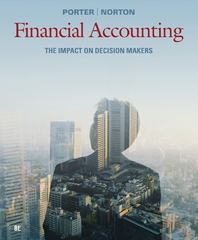Question
Assume the following income streams and ordinary tax rates: Year -2 Year -1 Year 0 Year 1 Year 2 Income (loss) $75,000 $125,000 $125,000 ($150,000)
- Assume the following income streams and ordinary tax rates:
|
| Year -2 | Year -1 | Year 0 | Year 1 | Year 2 |
| Income (loss) | $75,000 | $125,000 | $125,000 | ($150,000) | $175,000 |
| Ordinary tax rates | 21% | 21% | 21% | 21% | 35% |
The $150,000 loss in Year 1 resulted because the revenues for the year of $100,000 were less than the $250,000 of costs that year.
Tax rules for the period: Throughout the entire period, losses do not obtain a tax benefit unless it can be carried back or carried forward to offset taxable income. Assume that the carryback period for all years is 2 years and that, if there is not sufficient taxable income to offset some of the loss in the current year (which provides an immediate refund), the remainder is carried forward to lower next years (future years) taxable income. In this problem, assume the firm does not have any opportunity to invest and obtain additional interest income by having access to the income in Year 1 rather than Year 2 (i.e., ignore the time value of money). The tax planning decision: In Year 1, the CFO suggests that the firm defer recognition of $75,000 out of $100,000 of the revenues that year to be recognized instead in Year 2.
- What will be the amount of tax refund (negative dollar value) in Year 1 if the firm does NOT defer the $75,000 of income until Year 2?
- $31,500 tax refund
- $47,250 tax refund
- $52,500 tax refund
- $78,750 tax refund
- None of the above. Write in the amount: $______________________
- What will be the amount of tax due (positive dollar value) in Year 2 if the firm does NOT defer the $75,000 of income until Year 2?
- $36,750 taxes due
- $52,500 taxes due
- $61,250 taxes due
- $87,500 taxes due
- None of the above. Write in the amount: $______________________
- What will be the amount of tax refund (negative dollar value) in Year 1 if the firm does defer the $75,000 of income until Year 2?
- $31,500 tax refund
- $47,250 tax refund
- $52,500 tax refund
- $78,750 tax refund
- None of the above. Write in the amount: $______________________
- What will be the amount of tax due (positive dollar value) in Year 2 if the firm does defer the $75,000 of income until Year 2?
- $36,750 taxes due
- $52,500 taxes due
- $61,250 taxes due
- $87,500 taxes due
- None of the above. Write in the amount: $______________________
- Regardless to your actual answers to A.-D. above, assume that the answers to A.-D. are as follows:
| A. | -$25,000 |
| B. | $55,000 |
| C. | -$50,000 |
| D. | $100,000 |
Which option will the firm prefer?
- Follow the CFOs suggestion and defer recognition of the $75,000 to Year 2.
- Go against the CFOs suggestion and go ahead and keep the $75,000 loss as part of the loss for Year 1.
- The firm will be indifferent between the two options.
Step by Step Solution
There are 3 Steps involved in it
Step: 1

Get Instant Access to Expert-Tailored Solutions
See step-by-step solutions with expert insights and AI powered tools for academic success
Step: 2

Step: 3

Ace Your Homework with AI
Get the answers you need in no time with our AI-driven, step-by-step assistance
Get Started


